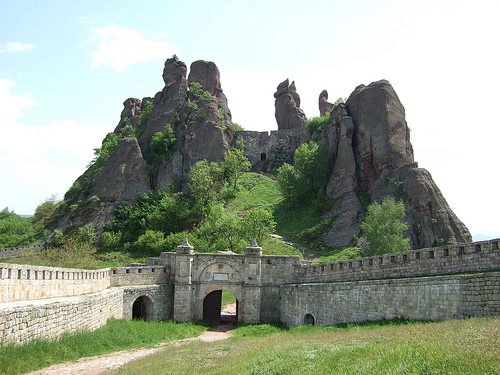

Location: Belogradchik, Vidin Province Map
Open: June-Sept: 8am-9pm
Oct-May: 9am-5pm
Belogradchik Fortress, also known as Kaleto (from Turkish "kale" meaning fortress), is an ancient stronghold located on the northern slopes of the Balkan Mountains in northwestern Bulgaria, near the town of Belogradchik in Vidin Province. Situated at coordinates 43°37′24″N 22°40′38″E, it is dramatically integrated into the surrounding Belogradchik Rocks—a series of striking sandstone and conglomerate formations up to 70 meters high, shaped by erosion over 230 million years from Triassic and Paleozoic geological layers. The fortress covers a total area of 10,210 square meters and is renowned for its seamless blend of human engineering with natural defenses, where massive rock massifs serve as impenetrable walls on three sides, with man-made fortifications primarily on the northwest and southeast. It is one of the best-preserved fortresses in Bulgaria, declared a cultural monument of national importance in 1965, and functions as a key historical and tourist site managed by the local historical museum. The site attracts visitors for its panoramic views, unique geological features, and layers of history spanning Roman, Byzantine, Bulgarian, and Ottoman eras.
The fortress's history dates back to the Roman Empire between the
1st and 3rd centuries AD, when it was initially constructed as a
surveillance outpost rather than a full defensive structure. The
Romans cleverly exploited the natural rock formations for
protection, building walls only where necessary and establishing the
highest section, known as the Citadel, to control the strategic road
from the Roman colony of Ratsiaria (near modern Archar). This early
phase focused on observation and basic fortification.
Following
the Roman period, the site was utilized by the Byzantines, Slavs,
and Bulgars between the 8th and 10th centuries, with further
rebuilding and fortification. A major expansion occurred in the 14th
century under Bulgarian Tsar Ivan Sratsimir of the Vidin Tsardom
(1356–1396), who transformed it into a formidable military
stronghold. During this time, fortified garrisons were added in
front of the rock massifs, making it the second most important
fortress in his realm after Baba Vida in Vidin. This upgrade was
driven by the looming threat of Ottoman expansion.
In 1396, the
Ottomans captured the fortress during their conquest of the last
Bulgarian kingdoms, incorporating it into their empire. It served as
a base to suppress local hajduk (bandit) activities and
insurrections. Significant reconstructions took place in the early
19th century (1805–1837), influenced by French and Italian
engineers, which introduced European architectural elements while
aligning with Ottoman styles. These changes enhanced its defensive
capabilities amid rising unrest.
The fortress played a pivotal
role in the Belogradchik Uprising of 1850, where Ottoman forces
suppressed Bulgarian rebels, executing leaders and displaying their
heads on the walls—a monument now commemorates this event. It saw
its last military use during the Serbo-Bulgarian War in 1885, after
which it fell into disuse. In the 20th century, it was recognized as
a cultural monument in 1965, cleaned, partly restored, and opened to
the public. No major recent restorations are reported for 2024–2025,
though it has been maintained for mass tourism.
Belogradchik Fortress is divided into three interconnected yards,
linked by gates, showcasing a masterful integration of architecture
and nature. The walls are over 2 meters thick at the base and reach
up to 12 meters in height, constructed primarily from local stone.
The Citadel, the highest and oldest Roman section, features gun
ports and offers sweeping views from points like the "First Slab."
Unique to the site is its reliance on the Belogradchik
Rocks—red-hued formations resembling figures (e.g., Madonna, Monks,
Adam and Eve)—as natural barriers, minimizing the need for extensive
walls.
Expansions include 14th-century Bulgarian garrisons and
19th-century Ottoman additions, such as reinforced bastions and
European-style elements. The fortress also encompasses over 100
nearby caves in the rocks, adding to its exploratory appeal, though
not all are accessible. Fossil findings in the area, including
Paleozoic plants and vertebrates, enhance its geological interest.
The fortress exemplifies multicultural influences across empires, symbolizing Bulgaria's layered history from Roman surveillance to Ottoman defense. It is a national cultural monument and part of the "Rocks of Belogradchik" on UNESCO's Tentative List since 2011 (criteria vii and viii) for its outstanding natural beauty, geological value, and cultural integration. The rocks' aesthetic, scientific, and ecological significance, combined with the fortress, make it a global standard for landscape heritage, comparable to sites like Cappadocia. It attracted around 90,000 visitors in 2015, underscoring its tourism draw. Local legends tied to the rock shapes add folklore value.
As of 2025, Belogradchik Fortress is in excellent condition, well-maintained and restored for public access, with no reported ongoing major restorations. It is protected under Bulgaria's Protected Areas Act as part of the Natural Monument "Belogradchik Rocks" (enlarged to about 6,319 decares) and within a Natura 2000 site. Entry costs about 6 BGN (around 3€), with audio guides available. Visitors praise its breathtaking views, historical atmosphere, and guided tours (e.g., by locals like Hristo), rating it highly (4.7/5 on Tripadvisor). It is accessible but requires comfortable shoes for rocky terrain; the top may challenge those with mobility issues. Best visited via car (3 hours from Sofia), with parking nearby. Events like opera performances (e.g., Wagner and Verdi in past years) occur occasionally, though none specific to 2024–2025 are noted. Nearby attractions include Magura Cave; combine for a full day trip.
Guest House Viko Hostel (Viko Hostel)
Belogradchik, 5 Tsar Ivan Sratsimir Str
+359878364306 Satellite
TV, Wi-Fi Internet
Hotel Dalia (Hotel Dalia)
Belogradchik,
1 Saedinenie Bul
+359-888-641-528
Satellite TV, Wi-Fi Internet
Hotel-Restaurant Skalite
+359-898-733-818
Hotel-Tavern
Madonna
+359-936-5546
satellite TV
Guest house Near The
Oak at Plamen
+359-896-795426